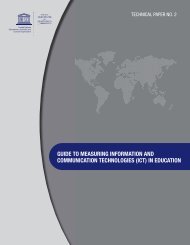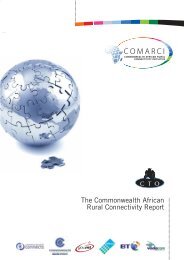ict in agriculture - Commonwealth Telecommunications Organisation
ict in agriculture - Commonwealth Telecommunications Organisation
ict in agriculture - Commonwealth Telecommunications Organisation
You also want an ePaper? Increase the reach of your titles
YUMPU automatically turns print PDFs into web optimized ePapers that Google loves.
SECTION 1 — OVERVIEW OF ICT IN AGRICULTURE: OPPORTUNITIES, ACCESS, AND CROSS-CUTTING THEMES 25<br />
Several key technology parameters should be considered <strong>in</strong><br />
decisions about the expansion of rural connectivity and the<br />
choice of technological delivery mechanism. They <strong>in</strong>clude the<br />
availability of spectrum frequencies, number of base stations<br />
needed to cover an area of specific size given a fixed operat<strong>in</strong>g<br />
frequency, achievable connection speed, data transmission<br />
rates, and downl<strong>in</strong>k and upl<strong>in</strong>k speeds.<br />
Given the complexity of such decisions, the role of the regulatory<br />
environment should be to expand the set of viable technology<br />
options. Flexibility <strong>in</strong> allow<strong>in</strong>g licensed and unlicensed<br />
use of operational frequencies can be advisable. Wellenius<br />
(2002) describes how Chile identified cost-effective solutions<br />
to reduce the gap between urban and remote areas <strong>in</strong> access<br />
to basic c ommunications technology.<br />
The “digital dividend” has been widely hailed as the solution<br />
to urban-rural <strong>in</strong>equities <strong>in</strong> digital ICT access. The “digital<br />
dividend” is the reassignment of operational frequencies<br />
that become available follow<strong>in</strong>g the switch from analog to<br />
digital television broadcast<strong>in</strong>g. The Geneva 2006 Agreement<br />
sets June 17, 2015 as the f<strong>in</strong>al date for protect<strong>in</strong>g currently<br />
assigned analogue television transmission frequencies. The<br />
digital dividend spectrum is found between 200 megahertz<br />
(MHz) and 1 gigahertz (GHz). It offers a comb<strong>in</strong>ation of<br />
transmission capacity and distance coverage conducive to<br />
the extension of wireless broadband <strong>in</strong>frastructure <strong>in</strong> rural<br />
areas. Us<strong>in</strong>g this spectrum, a few stations can transmit with<br />
high power, thereby provid<strong>in</strong>g Internet coverage to large<br />
rural areas where population is low and demand sparse.<br />
The advantage is the low capital expenditure required; the<br />
downside is the low bandwidth available to <strong>in</strong>dividual users.<br />
The process is accepted as <strong>in</strong>evitable, however, and it provides<br />
opportunities for efficient spectrum management <strong>in</strong><br />
rural areas.<br />
How to reassign digital dividend frequencies efficiently<br />
rema<strong>in</strong>s open to debate. Some advocate the reassignment<br />
of analog transmission frequencies to MNOs, without impos<strong>in</strong>g<br />
requir<strong>in</strong>g that rural <strong>in</strong>frastructure <strong>in</strong>vestments be tied to<br />
urban <strong>in</strong>frastructure <strong>in</strong>vestments (Picot et al. 2010). Others<br />
propo se allocat<strong>in</strong>g the digital dividend frequencies to shortrange<br />
communications. Countries’ experiences with the<br />
crossover to digital television have varied and rema<strong>in</strong> difficult<br />
to evaluate, as the process is still unfold<strong>in</strong>g (box 2.5 has an<br />
example from South Africa).<br />
Some observers (Nedevschi et al. 2010) have considered<br />
CDMA450 a solution to rural connectivity problems (it is<br />
ECONOMIC AND SECTOR WORK<br />
BOX 2.5: Lessons from South Africa’s Experience <strong>in</strong><br />
Migrat<strong>in</strong>g to Digital Television<br />
South Africa developed a digital migration strategy<br />
to stimulate growth <strong>in</strong> its electronics manufactur<strong>in</strong>g<br />
sector. The strategy featured a digital switch-on date<br />
<strong>in</strong> 2008 and an analog switch-off date at the end of<br />
2011. The reduced costs of simultaneous analog and<br />
digital broadcast<strong>in</strong>g (€ 750 million for three years)<br />
were considered a strong advantage of the ambitious,<br />
three-year migration plan. Other expected costs<br />
<strong>in</strong>cluded € 800 million for the digital rollout, as well<br />
as € 2.5–3.5 billion for subsidies to local manufacturers<br />
produc<strong>in</strong>g digital set-top boxes. In early 2011, the<br />
South African m<strong>in</strong>ister of communications announced<br />
that the switch from analog would be postponed until<br />
December 31, 2013. Observers have raised questions<br />
about the practicality of the plans and even the<br />
postponed date. The lesson is that the certa<strong>in</strong> costs<br />
of switchover plans need to be balanced aga<strong>in</strong>st their<br />
uncerta<strong>in</strong> benefits, <strong>in</strong>clud<strong>in</strong>g the uncerta<strong>in</strong> demand<br />
for the released telecommunications spectrum and<br />
for additional digital TV services.<br />
Source: Author, based on Pham 2009; Armstrong and Coll<strong>in</strong>s<br />
2011; and Government of South Africa, “Statement by M<strong>in</strong>ister<br />
of Communications,” January 14, 2011 (http://www.doc.gov.za/<br />
<strong>in</strong>dex.php?option=com_content&view=article&id=478:statementby-the-honorable-m<strong>in</strong>ister-of-communications-mr-radhakrishna-lpadayachie-roy-on-progress-made-with-regards-to-the-digital-migrationprocess&catid=88:press-releases,<br />
accessed July 2011).<br />
used for this purpose <strong>in</strong> Kazakhstan; see box 2.6). CDMA450<br />
is a cellular technology based on the CDMA2000 standard,<br />
with an operat<strong>in</strong>g frequency of 450 MHz. The technology<br />
uses the same air <strong>in</strong>terface as CDMA2000 but operates at<br />
a lower frequency and is able to offer the same basket of<br />
high-speed voice and data connectivity over a greater range,<br />
thereby imply<strong>in</strong>g lower capital expenses. In rural sett<strong>in</strong>gs,<br />
CDMA450 has a range of up to 50 kilometers. Ow<strong>in</strong>g to a<br />
process known as “cell breath<strong>in</strong>g,” however, such ranges<br />
are not achievable under cell loads approach<strong>in</strong>g cell capacity.<br />
CDMA450 appears to be best suited to mixed urban-rural<br />
deployments, <strong>in</strong> which urban deployments are capacitycentric<br />
and rural deployments are coverage-centric. Another<br />
disadvantage of CDMA450 is the large antenna required to<br />
allow the extended coverage for meet<strong>in</strong>g low rural demand.<br />
The major limitation of CDMA450 solutions is the scarcity<br />
of mobile devices that can use the 450 MHz frequency (the<br />
majority operate at 900–1800 MHz.

















